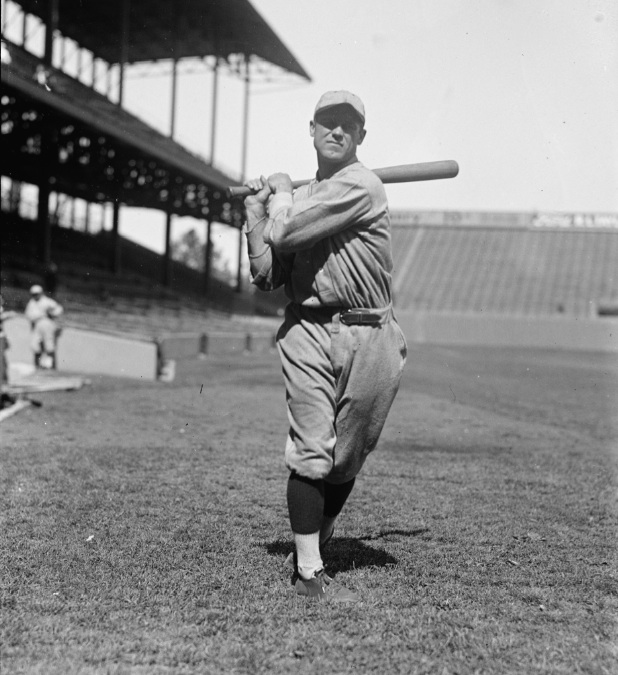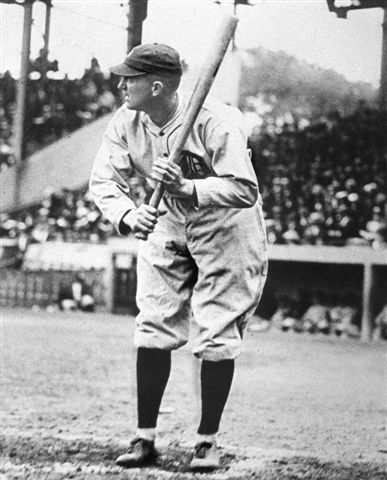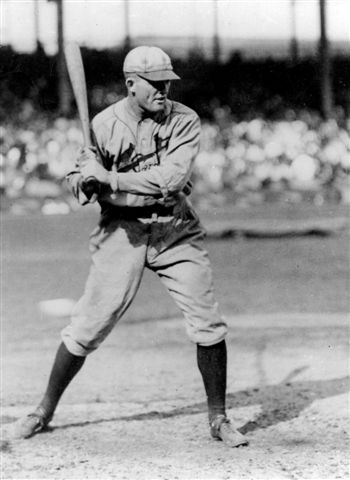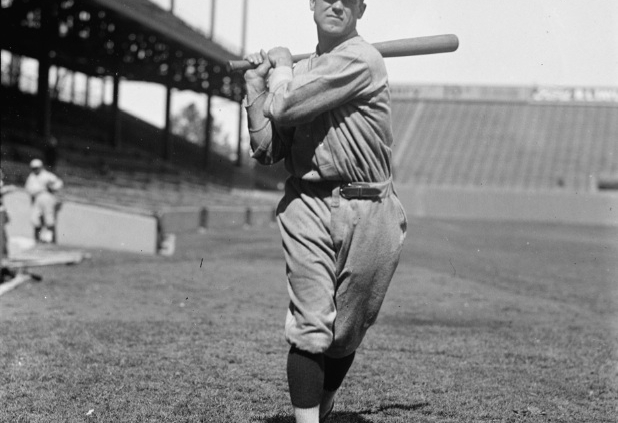The Three, or Was It Two, .400 Hitters of 1922
This article was written by Brian Marshall
This article was published in Spring 2014 Baseball Research Journal
The .400 batting average (BA) for an individual in a single season has been the standard of hitting excellence all batting champions have sought, but few have achieved. In fact, the last time it was accomplished was in 1941 when Ted Williams of the Boston Red Sox managed the feat with a .406 BA. To find the last season when there were multiple .400 hitters, the baseball historian has to turn the pages of major league history back even further, to 1922. Not just one but three players finished the season with a batting average of .400 or above.
The three were all eventual Hall of Famers: George Sisler and Ty Cobb in the American League and Rogers Hornsby in the National League. Of the three, Sisler’s .420 stood head and shoulders above the .401 BA of the other two, but the real significance of the .420 BA is that 1900–22 there had only been two other players who had hit .420 or better in a single season: Nap Lajoie in 1901 (.426) and Ty Cobb in 1911 (.420 BA).1
 A further point of significance regarding 1900–22: the 1911 season—in which Ty Cobb batted .420 and Joe Jackson .408—was the only other season with more than one .400 hitter.
A further point of significance regarding 1900–22: the 1911 season—in which Ty Cobb batted .420 and Joe Jackson .408—was the only other season with more than one .400 hitter.
The chart below displays the cumulative batting averages for each of the three players with respect to each other, as well as the portions of the season each player was at or above .400. Some key periods for each player are as follows:
- George Sisler, of the St. Louis Browns, was above the .400 mark for all but two games, with a peak at Game Number 9 of .500. Sisler’s 41-game hit streak occurred during the 51-game period. Sisler did not play in 10 games, from Game Number 94 (July 27) to Number 144 (September 17).
- Rogers Hornsby, of the St. Louis Cardinals, was below .400 for much of the season, a direct contrast to his 1921 season where he was above .400 for essentially the whole season only to fall below .400 in the final game. Hornsby’s 33-game hit streak occurred from Game Number 110 (August 13) through Number 142 (September 19).
- Ty Cobb, of the Detroit Tigers, was at or above .400 for more than a third of the games he played in. Cobb’s month of July occurred from Game Number 70 (July 1) through Number 101 (July 31).
The 1922 St. Louis Browns contended for the AL pennant with the New York Yankees for almost the whole season. Although they finished strong, it was too little too late. They tallied a 93–61 record to the Yankees 94–60. Their key player was Sisler, who was recognized for his efforts with the inaugural AL MVP award as voted by the baseball writers. Sisler had led the league in batting average (.420) and hits (246), and had the longest consecutive game hit streak (41). Sisler was second in total bases with 348 and in on-base average with .467. Amazingly, Sisler only had 14 strikeouts in 1922. As for fielding, Sisler led in assists at first base with 125. The 41-game hit streak was an AL record at the time. Both Sisler and teammate Ken Williams had their streaks snapped by the Yankees; Sisler’s was stopped on September 18 and Williams’s was stopped at 28 games on August 25.
The 1922 season of Rogers Hornsby was so prominent in terms of the categories he led in that it really comes down to what didn’t he do. Hornsby won the NL Triple Crown, the first of two Triple Crowns in his career.2
In addition to leading the NL in batting average (.401), home runs (42), and RBIs (152), Hornsby also led in hits (250), doubles (46), OPS (1.181), and many other categories, and had the longest hit streak (33 games). Hornsby also led in double plays turned by a second baseman (81) among other top defensive stats. Like I said, what didn’t he do? Many of the achievements were also NL records at the time and were tops by a right-hander. Hornsby’s .722 Slugging Average was an NL record at the time and that 1.181 OPS was the second-highest in NL history.3
 The last, but by no means least, of the hitters to be discussed is Ty Cobb. While Cobb did not win a Triple Crown or an MVP, and his batting average did not exceed that of Hornsby, let alone Sisler, it can be argued that in some ways Cobb topped them both. Cobb had five hits in four separate games, all nine-inning games, and three of the games were during the month of July when he had 67 hits. (An article in The Times from October 8 reported Cobb having only three games with five hits. It is not accurate.)4 In three of the five-hit games, Cobb was 5-for-5, and of special interest is the game on May 7 against the Chicago White Sox, in which Cobb had a home run, three doubles, and a single for 11 total bases, four RBIs, and two runs scored.
The last, but by no means least, of the hitters to be discussed is Ty Cobb. While Cobb did not win a Triple Crown or an MVP, and his batting average did not exceed that of Hornsby, let alone Sisler, it can be argued that in some ways Cobb topped them both. Cobb had five hits in four separate games, all nine-inning games, and three of the games were during the month of July when he had 67 hits. (An article in The Times from October 8 reported Cobb having only three games with five hits. It is not accurate.)4 In three of the five-hit games, Cobb was 5-for-5, and of special interest is the game on May 7 against the Chicago White Sox, in which Cobb had a home run, three doubles, and a single for 11 total bases, four RBIs, and two runs scored.
The most notable of all the games Cobb played that season, though, fell on May 15, and not because any particularly notable hitting feat was achieved. The Tigers faced the Yankees that day at the Polo Grounds. AL president Ban Johnson attended the game. “Ban sat in a box with his old college chum, Colonel Tillinghast Huston” according to the New York Times.
Huston, at the time, was co-owner, with Jacob Ruppert, of the New York Yankees. At the time, the game was otherwise not noteworthy, but on October 21, a report came out of Chicago that brought attention to it. Apparently while compiling the season statistics, the official statistician for the AL, Irvin M. Howe, discovered a discrepancy in the number of hits credited to Cobb.
The matter would be brought before Johnson for an official decision. The discrepancy of a single hit stood between the newspaper box scores and the account of the official scorer. The hit, if counted, meant a total of 211 for the season and a .401 BA. If not counted, Cobb’s BA would drop to .398. Statistics issued after the season appeared in the New York Times on October 8, listing Cobb’s batting statistics as 627 at bats (presumed to be a typo and should have been 527) and 210 hits, which yields a .398 BA.5
The .398 number conflicts with another small article that appeared on October 2, also in the New York Times, entitled “Ty Cobb Ties Three League Batting Records.”
DETROIT, Oct. 1 – Three major league batting records were tied by Ty Cobb in the season that closed today. The Georgia [sic] has hit .300 or better for seventeen years, has 200 or more safeties to his credit in eight seasons and has batted .400 or better in three seasons.
His single at Cleveland today assured him of a tie for the 400 percent [sic] record, the hit making his average for the season slightly above that mark.6
The October 8 article interestingly lists Sisler’s batting statistics as 688 at bats (presumed to be a typo and should have been 588) and 244 hits which yields a .415 BA.
According to an October 24 article entitled “Cobb’s Chance of .400 Average Slim” in the New York Times, the circumstances involving the disputed hit were reported as follows:
During the game of May 15 rain suddenly came up and forced the spectators in exposed seats to seek shelter further up in the stand. Among those who retreated to the covered seats were the official scorer and two local newspaper men. Shortly afterward Cobb hit a grounder straight at Everett Scott, who fumbled and kicked the ball into centre field so far that Blue was able to score from second base. The two reporters who were sitting with the official scorer, one of whom was with The Times, immediately called the play an error, and the scorer agreed with them. But an unofficial score, sent out by a reporter sitting in the press box and not in touch with the official scorer, credited Cobb with a hit, giving him two singles for the game.
In conformity with the official decision, the New York Times the next day changed the unofficial box score so as to give Cobb only one hit. There was some doubt about the play, and it could have been scored either as a hit or an error. But inasmuch as the official version was that the play was an error, there seems but little hope that this decision will be reversed by President Johnson.7
The Times recap of the May 15, 1922, game stated the following regarding the play alluded to in the October 24 article: “The bustling Cobbites added another tally in the seventh. Blue singled over to second, Jones sacrificed and Deacon Everett Scott booted Cobb’s grounder and kicked it into centre field, giving Blue ample time to hasten across the platter.”8
 The box score for the game indicated Cobb had one hit in three at bats and Scott had the only error of the game. An interesting note regarding the rain is the fact the game recap did not mention the rain at all, although it clearly appeared to be a factor according to the October 24 article.9
The box score for the game indicated Cobb had one hit in three at bats and Scott had the only error of the game. An interesting note regarding the rain is the fact the game recap did not mention the rain at all, although it clearly appeared to be a factor according to the October 24 article.9
Further fuel was added to the controversy when the official AL batting statistics were released on Monday, December 4. The statistics indicated Sisler was the leading batter of the AL with a .419 BA—not entirely accurate, given that .41980 should be rounded to .420. The Times published the season totals with the following commentary:
The greatest surprise in the records was contained in the average credited to Ty Cobb of Detroit, whose mark has been changed by Ban Johnson from its original .398 to .401, thereby entitling the veteran to join Jesse Burkett in the very select circle which can boast of three .400 marks or better in its big-league career. The records reveal for the first time that President Johnson officially overrode the decision of the scorer in New York on one play and changed an official error into an official hit.10
So it is that, at least according to the country’s paper of record, Cobb’s batting average was on a rollercoaster: reported in the Times on October 2 as being “slightly above” .400 , then .398 on October 8, reiterated on October 24, then changed to the final value, of .401, in the official AL statistics issued on December 4 and published in the New York Times the same day.
An official statement out of Chicago by AL President Johnson was provided on December 7, 1922, and reported in the New York Times on December 8, 1922: “The official score of the game at New York between the Yankees and Detroit was not authenticated.” The Times article went on to detail the arrangement between the AL official scorer and the Associated Press (AP) to check all box scores from AL parks according to Johnson:
This provision (the above mentioned arrangement) was carried out in the game in question and Cobb credited with a hit. If a change in the box score was made it was without notice to the Associated Press, and the American League official statistician sensibly accepted the Associated Press account.11
The Times article further commented that “Reports from New York that the official scorer reversed his decision were unsubstantiated at the American League headquarters here,” as well as stating that no poll of baseball writers present at the game was taken. Then, while the baseball writers were still reeling from the fact that Cobb was credited with a .401 BA, Cobb provided the following comments per the New York Times on December 9, 1922:
The several baseball writers who have so interested themselves in the disputed hit also should turn their attention to what happened on my last trip to New York in the 1921 season. Let them tell me and the public why it was three safe hits were taken from me during that series and two times at bat added. I would also like an explanation as to why the official score in the disputed hit game of last May was not authenticated.12
The Associated Press scorer on May 15, 1922, was Frederick Lieb who was also the President of the Baseball Writers Association. Mr. Lieb was reported in the Times of December 9, 1922, as saying the following:
The American League had no authority to accept the unofficial score of the Detroit-Yankee game played in New York on May 15, 1922, in preference to the official score. My failure to agree with the official scorer in the disputed play was due to the fact that it was a rainy afternoon and Mr. Kieran, the official scorer, left the press stand for the covered section of the grandstand. Had Mr. Kieran been in the press stand the Associated Press score compiled by me would have agreed with the official score. There would be no further need for members of the Baseball Writers’ Association serving as official scorers if their scores were relegated to a secondary position whenever they failed to agree with unofficial averages.13
Then the Baseball Writers started to show their solidarity, first by the New York Chapter of the Base Ball Writers Association, at a meeting on December 9, 1922, which generated a series of resolutions in support of the official scorer for the AL and against Cobb’s .400 BA. The resolutions, which were to also be sent to Commissioner Landis, further stated that all baseball record publications should be adjusted. The next show of solidarity was at the annual meeting of the Base Ball Writers Association of America, held on December 14, 1922, at the Hotel Commodore in New York. A motion was passed by four votes to three to accept the resolutions adopted by the New York Chapter. The article in the New York Times dated December 15, 1922, stated that the intent of the meeting was undoubtedly to stand behind the official scorer in question and thus to establish a precedent rather than to deprive Cobb of an average over .400.14 The Times also reported that Johnson was invited to the meeting but chose not to attend.
When all the dust had cleared, Cobb was on record as having achieved a .400 batting average for the 1922 season. This was probably the proper outcome given the events of the day for the game in question, not the least of which was the fact that the AP scorer, Frederick Lieb—who had remained in the press stand for the play while the official scorer had departed—gave Cobb credit for a hit on the disputed play.
The other aspect we can only speculate on is the timing of when the official scorer, a Mr. Kieran, actually left the press stand. We don’t know whether or not he saw the whole play. The newspaper descriptions make it sound as if the disputed hit was one of those that apparently could have been scored either way. Maybe Ban Johnson, who had attended the game, felt it was a hit and not an error and made his decision accordingly.
BRIAN MARSHALL is an Electrical Engineering Technologist living in Barrie, Ontario, Canada, and a long time researcher in various fields including entomology, power electronic engineering, NFL, Canadian Football and recently MLB. Brian has written many articles and two books in his 59 years. Brian is a long time member of the PFRA. While growing up, Brian participated in many sports including hockey, baseball, power lifting, arm wrestling, football and rugby, and aspired to be a professional football player. When that didn’t materialize, he focused on Rugby Union and played off and on for 17 seasons in the “front row.”
Sources
Roger A. Godin. The 1922 St. Louis Browns: Best of the American League’s Worst. Jefferson, NC: McFarland & Company, 1991. 239 pages.
Steve Steinberg. “The ‘Little World Series’ of 1922: The Most Heartbreaking Loss in St. Louis Baseball History,” The National Pastime 28 (2008): 7–14.
Paul Warburton. “Offense? Try Hornsby,” The Baseball Research Journal 28 (1999): 3–7.
Paul Warburton. “George Sisler,” The National Pastime 19 (1999): 93–97.
1922 Season AL, St. Louis Browns. http://www.baseball-reference.com.
1922 Season AL, Detroit Tigers. http://www.baseball-reference.com.
1922 Season NL, St. Louis Cardinals. http://www.baseball-reference.com.
Single Season Records. http://www.baseball-reference.com.
Career Records. http://www.baseball-reference.com.
Yearly Leaders. http://www.baseball-reference.com.
General Reference. http://www.baseball-almanac.com.
May 15, 1922 Detroit Tigers vs New York Yankees game. http://www.retrosheet.org.
General Reference. http://www.retrosheet.org.
Discrepancy File for George Sisler. http://www.retrosheet.org.
Discrepancy File Ty Cobb. http://www.retrosheet.org.
General Reference. The New York Times.
Notes
1 When the batting averages are calculated to four decimal places it is clear that both Sisler’s 1922 BA and Cobb’s averages are less than .420, being .4198 and .4196 respectively. When rounded to three decimal places, as the batting averages are traditionally calculated, they are represented as .420. Recent research of the individual game box scores for the complete 1922 season, as presented on the Baseball-Reference.com and Retrosheet (including the Sisler discrepancy file) websites indicate that Sisler’s numbers are 244 hits in 587 at bats for a BA of .416. Jesse Burkett was typically credited with three .400 seasons, being 1895, 1896, and 1899, in the various record books up to publication of The Baseball Encyclopedia in 1969, which was the start of the present trend to credit Burkett with only two .400 seasons, 1895 and 1896.
2 Only one other player also won two batting Triple Crowns: Ted Williams in the AL.
3 At the time the record for highest single season OPS in the NL was 1.196, established by Hugh Duffy in 1894.
4 “Hornsby and Sisler Are Champion Batsmen of the Major Leagues,” New York Times, October 8, 1922.
5 “Hornsby and Sisler Are Champion Batsmen of the Major Leagues,” New York Times, October 8, 1922.
6 “Ty Cobb Ties Three League Batting Records,” New York Times, October 2, 1922.
7 “Cobb’s Chance of .400 Average Slim,” New York Times, October 24, 1922.
8 “Yankees Shackled by Detroit Rookie,” New York Times, May 16, 1922.
9 The rain is also mentioned in the play-by-play coverage of the game at Retrosheet, where it states that following in the Tigers fifth: “rain started falling fairly hard.”
10 “American League Batting Title is Won by Sisler; Cobb Second,” New York Times, December 4, 1922.
11 “Johnson Explains Ruling on Cobb,” New York Times, December 8, 1922.
12 “Ty Cobb Calls for Scoring Clean-Up,” New York Times, December 9, 1922.
13 “Ty Cobb Calls for Scoring Clean-Up,” New York Times, December 9, 1922.
14 “Scorer Upheld by Baseball Writers,” New York Times, December 15, 1922. “The motion to go on record in support of the resolution was passed by 4 votes to 3, New York, Boston, Brooklyn and Pittsburgh voting favorably and Cleveland, Detroit and Philadelphia opposing it. The Philadelphia representative voted against the motion under the misapprehension that a vote to sustain it would put the baseball writers in all cities on record as declining to serve as official scorers in future.”



